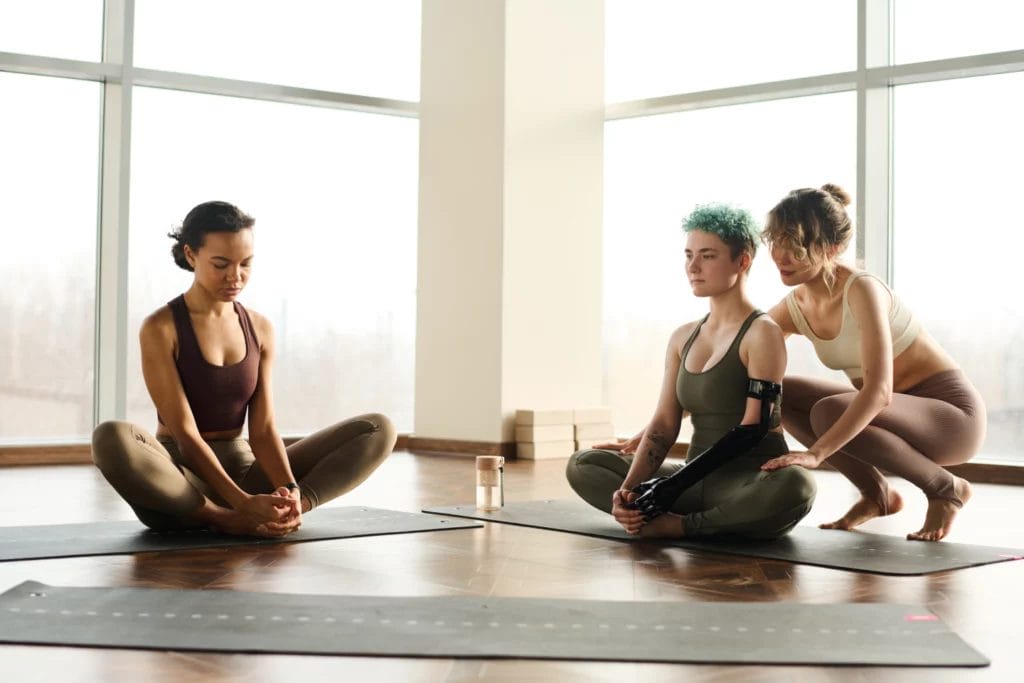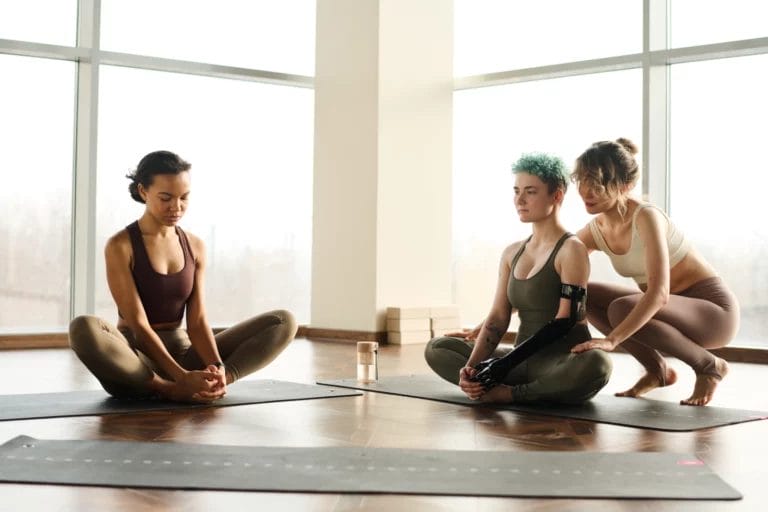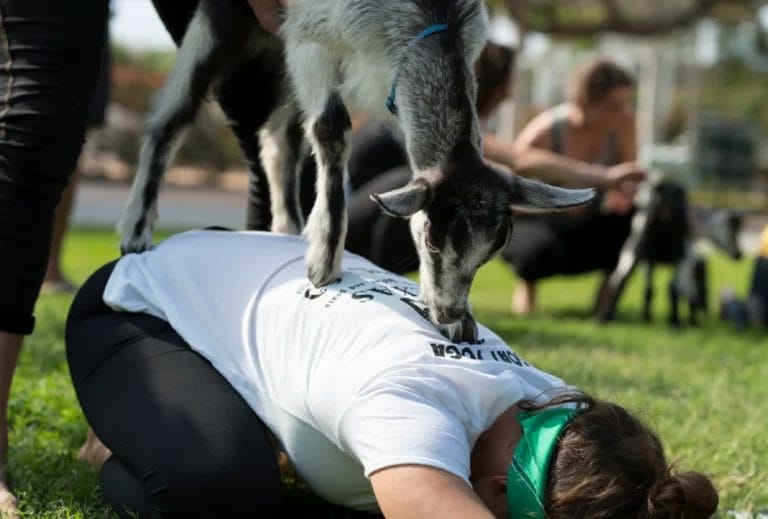Yoga teacher insurance is a financial safety net for yoga instructors. In the event of accidents, injuries, and other mishaps, yoga teacher insurance is there to help keep you from going broke.
Why Yoga Teachers Need Liability Insurance
Anyone who works with the general public needs liability insurance. Liability insurance applies to injuries and harm you or your business unintentionally do to others (aka “the public”).
Yoga instructors need liability insurance to help protect their bank accounts and reputations in case of claims or lawsuits.
Injuries and property damage costs: $100s to $100,000s
Insurance Canopy liability insurance: $15/month or $159/year
Your bank account: -$159/year for insurance? Or -$500 to -$50,000 for one injury claim?
Plus, if you teach in a gym or studio, you may be required to carry your own liability insurance as a condition of your employment.
Are you covered under your employer’s insurance policy? Don’t hold your breath! Many facilities make you carry your own insurance.

What Yoga Teacher Insurance Covers
Yoga instructor insurance is liability insurance designed for yoga teachers and teachers-in-training. It follows you wherever you teach: in person, in multiple studios, online, or all the above.
Insurance Canopy policies include the following parts, with each part covering certain kinds of risks.
Pro Tip: Canopy covers a variety of yoga styles. Plus, one Canopy policy covers you if you teach several kinds of yoga, or additional fitness classes in addition to yoga.
General Liability
General liability insurance covers bodily injury and property damage you or your business operations cause to others. These kinds of damages usually happen during your class or in the physical location you teach.
Bodily injury examples:
- A client sprains a wrist during a sun salutation
- A student falls and cuts their lip open, needing stitches
- You accidentally dislocate a student’s shoulder while assisting them with a pose
Property damage examples:
- You crack a client’s phone screen after accidentally stepping on it
- Your student knocks over a storage shelf and it breaks
Professional Liability
Professional liability insurance is also called Errors & Omissions (E&O) Insurance. It covers injury or damage claims caused by your professional services, advice, or instructions.
These damages may happen outside of your class, but you’re still blamed for causing them.
Examples:
- A student accuses you of causing them to develop carpal tunnel due to the prolonged holds you include in class
- A client sustains an injury after performing a pose the way you instructed in a pre-recorded video
Pro Tip: Some companies sell professional liability insurance separately from general liability. Insurance Canopy includes both professional and general liability in our base instructor policy.
Personal and Advertising Injury
Personal and advertising injury insurance covers harm or damage that is not physical. With Insurance Canopy, this coverage is included under general liability (meaning it is not purchased separately).
Typically, this coverage applies to things like invasion of privacy, defamation, and copyright infringement.
Examples:
- You share a client’s transformation video on social media without their consent
- Another independent instructor accuses you of stealing their marketing imagery
- A local gym accuses you of slander after you made negative comments about them on your YouTube channel

Products-Completed Operations
Products-completed operations coverage applies to physical injury or property damage caused by a product you provide or sell during or after your class.
Examples:
- A faulty resistance band snaps and scratches a client’s cornea after class
- An essential oil blend you sell causes a severe allergic reaction in a student
Damage to Rented Premises
Rented premises coverage is for damages to a studio or other space you rent to teach in.
Examples:
- You rent time in a shared-use facility to run your ashtanga yoga class and spill tea on the entryway carpet, permanently staining it
- You rent studio space to conduct a private prenatal yoga workshop and an attendee bumps into a wall, cracking a mirror
Medical Expense
Medical expense coverage applies to smaller medical bills of someone who was injured in or around your class, regardless of fault.
Examples:
- One participant accidentally knocks over another during a class, resulting in a sprained knee
- A student drops a two-pound weight on another participant’s foot during one of your classes and breaks their toe
Pro Tip: Learn more about yoga insurance and optional add-on coverages like equipment and gear coverage with our ultimate yoga liability insurance guide.

Occurrence-Form vs. Claims-Made Policies for Yoga Instructors
“Claims-made” and “occurrence-form” are the types of policies you can have. The terms refer to how claims must be filed with each.
Claims-Made
With claims-made policies, you must file claims within a specific time frame. So if someone is injured in one of your classes and you don’t report it to the insurance company until after your policy expires, it would not be covered.
Occurrence
With occurrence policies, you’re covered whenever you report the incident, as long as the incident itself happened during your policy period.
Pro Tip: Canopy yoga teacher policies are occurrence policies.
Claims-made = The incident must happen and the claim reported while the policy is active
Occurrence = The incident must happen while the policy is active, but can be reported at any time
How to Buy Yoga Teacher Insurance Online
Getting your yoga instructor insurance is quick and easy with Canopy’s online application.
- Start the process by choosing yoga on the checkout page
- Opt in or out to any additional coverages when prompted
- Fill in your personal information, like name and address
- Provide your business information and confirm eligibility questions
- Add additional insureds if desired
- Choose your policy start date and review your coverage choices
- Choose annual or monthly payments and input payment info
Congrats! You’re insured!
A few seconds after processing payment, you’ll receive an email confirmation and instant access to your certificate of insurance through your online dashboard. You may also update and manage your policy via the dashboard anytime.

Common Questions About Yoga Teacher & Instructor Insurance
Does Yoga Teacher Insurance Cover Workshops, Retreats, or Teacher-Training Courses?
Yoga instructor insurance covers you while you are teaching; workshops, retreats, and teacher trainings included. As long as these classes and events are within the United States, you are covered.
Do Waivers and Release Forms Replace the Need for Insurance?
No. Waivers and release forms are good to have as an additional layer of protection in the event of an accident. They allow you to get participants’ informed consent, but they do not replace the need for insurance or provide any guaranteed legal protection.
Do I Need to Be Yoga Alliance–Certified to Buy Coverage?
No. You need to be qualified to teach yoga or in the process of obtaining your yoga instructor certification, but you don’t have to be certified by Yoga Alliance specifically.
Are Aerial, Acro-Yoga, SUP Yoga, or Hot Yoga Classes Automatically Included?
Not all these yoga styles are covered. Hot yoga and acro-yoga are usually included. Aerial and stand-up paddleboard (SUP) yoga are typically excluded. Check our covered yoga styles for the full list of exclusions.
Do I Need Separate Policies if I Teach Multiple Modalities (e.g., Pilates, Meditation, Reiki)?
You do not need separate policies for related modalities. Insurance Canopy policies cover you if you teach multiple modalities like yoga, Pilates, and reiki. You can select multiple modalities or add things like Reiki under the “other” category on your application.
However, if you primarily provide bodywork services like reiki or massage, and only offer yoga sometimes, you may want to get a Beauty and Bodywork policy with a fitness endorsement instead.





